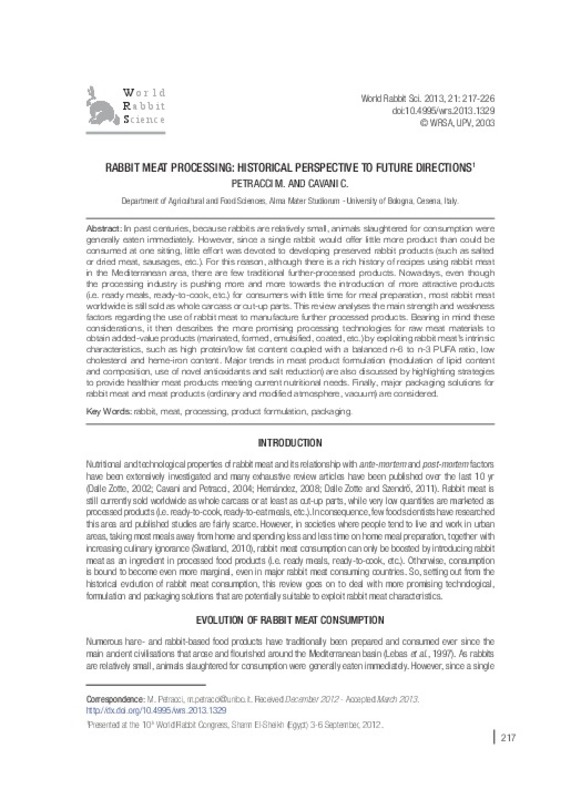JavaScript is disabled for your browser. Some features of this site may not work without it.
Buscar en RiuNet
Listar
Mi cuenta
Estadísticas
Ayuda RiuNet
Admin. UPV
Rabbit meat processing: historical perspective to future directions
Mostrar el registro sencillo del ítem
Ficheros en el ítem
| dc.contributor.author | Petracci, Massimiliano
|
es_ES |
| dc.contributor.author | Cavani, Claudio
|
es_ES |
| dc.date.accessioned | 2014-01-17T12:16:22Z | |
| dc.date.available | 2014-01-17T12:16:22Z | |
| dc.date.issued | 2013-12-27 | |
| dc.identifier.issn | 1257-5011 | |
| dc.identifier.uri | http://hdl.handle.net/10251/34953 | |
| dc.description.abstract | [EN] In past centuries, because rabbits are relatively small, animals slaughtered for consumption were generally eaten immediately. However, since a single rabbit would offer little more product than could be consumed at one sitting, little effort was devoted to developing preserved rabbit products (such as salted or dried meat, sausages, etc.). For this reason, although there is a rich history of recipes using rabbit meat in the Mediterranean area, there are few traditional further-processed products. Nowadays, even though the processing industry is pushing more and more towards the introduction of more attractive products (i.e. ready meals, ready-to-cook, etc.) for consumers with little time for meal preparation, most rabbit meat worldwide is still sold as whole carcass or cut-up parts. This review analyses the main strength and weakness factors regarding the use of rabbit meat to manufacture further processed products. Bearing in mind these considerations, it then describes the more promising processing technologies for raw meat materials to obtain added-value products (marinated, formed, emulsified, coated, etc.) by exploiting rabbit meat¿s intrinsic characteristics, such as high protein/low fat content coupled with a balanced n-6 to n-3 PUFA ratio, low cholesterol and heme-iron content. Major trends in meat product formulation (modulation of lipid content and composition, use of novel antioxidants and salt reduction) are also discussed by highlighting strategies to provide healthier meat products meeting current nutritional needs. Finally, major packaging solutions for rabbit meat and meat products (ordinary and modified atmosphere, vacuum) are considered. | es_ES |
| dc.language | Inglés | es_ES |
| dc.publisher | Editorial Universitat Politècnica de València | |
| dc.relation.ispartof | World Rabbit Science | |
| dc.rights | Reserva de todos los derechos | es_ES |
| dc.subject | Rabbit | es_ES |
| dc.subject | Meat | es_ES |
| dc.subject | Processing | es_ES |
| dc.subject | Product formulation | es_ES |
| dc.subject | Packaging | es_ES |
| dc.title | Rabbit meat processing: historical perspective to future directions | es_ES |
| dc.type | Artículo | es_ES |
| dc.date.updated | 2014-01-17T12:04:15Z | |
| dc.identifier.doi | 10.4995/wrs.2013.1329 | |
| dc.rights.accessRights | Abierto | es_ES |
| dc.description.bibliographicCitation | Petracci, M.; Cavani, C. (2013). Rabbit meat processing: historical perspective to future directions. World Rabbit Science. 21(4):217-226. https://doi.org/10.4995/wrs.2013.1329 | es_ES |
| dc.description.accrualMethod | SWORD | es_ES |
| dc.relation.publisherversion | https://doi.org/10.4995/wrs.2013.1329 | es_ES |
| dc.description.upvformatpinicio | 217 | es_ES |
| dc.description.upvformatpfin | 226 | es_ES |
| dc.description.volume | 21 | |
| dc.description.issue | 4 | |
| dc.identifier.eissn | 1989-8886 |








